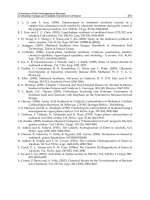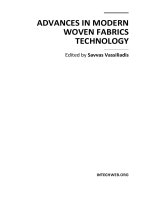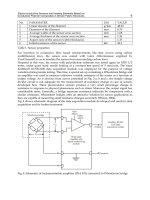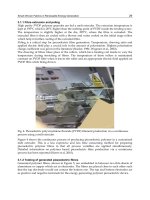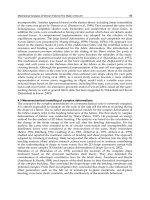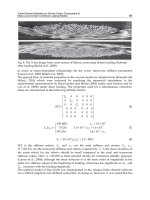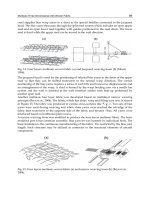Advances in Modern Woven Fabrics Technology Part 10 potx
Bạn đang xem bản rút gọn của tài liệu. Xem và tải ngay bản đầy đủ của tài liệu tại đây (876.58 KB, 20 trang )
Sensory and Physiological Issue
169
plain
4-satin
6-satin
12-satin
crêpe
5-satin
waved twill
4-twill
3-twill
-2,5
-1,5
-0,5
0,5
1,5
2,5
3,5
4,5
-3,0 -2,0 -1,0 0,0 1,0 2,0 3,0 4,0 5,0
Axe1
46.27
%
Axe2
27.81%
Falling
Responsive
Pilous
Grooved
Granulous
Soft
Slippery
Rigid
Crumple-like
Fig. 11. Principle Component Analysis, map of products
Plain weave, waved twill, crêpe and 12-satin have very distinguished tactile profiles as
compared to the other fabrics.
Knowing the correlations that may exist between fabric pattern and tactile properties,
manufacturers would be able to design specific touch by the weaving process instead of
using finishing treatments. This may be interesting in order to develop an environmental
friendly process and avoid the use of chemical products.
5.2 Effect of the yarn count on the fabric hand of cotton woven fabrics
All woven fabrics are made by yarns. It is therefore interesting to study the effect of yarn
properties on fabric hand. In this paragraph, on yarn property, the yarn count is studied.
The impact of this factor on fabric sensory properties is underlined.
Materials
The study is carried out on 4 fabrics having different weft counts: 25 Tex, 50 Tex, 71 Tex and
100 Tex. The other parameters are unchanged: 100% cotton, Warp count (14 Tex) and Index
of saturation (52%).
The experiment is applied on nine different patterns. Only the results of the plain weave are
presented in this paragraph.
Results and discussion
The ANOVA 2-way test (5%) revealed that 9 attributes are significantly affected. These
attributes are: thin-thick, light-heavy, supple-rigid, soft, granulous, grooved, falling, responsive and
elastic.
The sensory profiles are presented in Figure 12. It can be noticed that some attributes are
positively correlated to the yarn count. These attributes are: thin-thick, light-heavy, supple-
rigid, granulous and responsive.
On the map of products obtained by the Principle Component Analysis (Figure 13), it can be
noticed that fabrics are ranked on one principle axe (79.53%). On the left side of the axe,
there are fabrics with high yarn counts and they are correlated to thick, heavy, rigid,
Advances in Modern Woven Fabrics Technology
170
granulous, grooved, elastic and responsive attributes. The right side contains fabrics with low
yarn counts which are positively correlated to falling, thin, light, supple and soft attributes.
Those results are proven for the all other patterns: twills, satins and crêpe.
Fig. 12. Sensory profiles of plain weave fabrics with different yarn counts
Fig. 13. Map of products, yarn count effect
Conclusion
The study of the influence of yarn count on the touch quality of fabrics has been proven as
very important and has shown very interesting results. Surface properties as well as full
hand properties are strongly affected by the yarn count. The more the yarn count is
important, the more the fabric is granulous, grooved, thick, heavy, rigid and responsive.
This may help to control and evaluate fabric tactile properties by modifying the yarn
characteristics and parameters.
5.3 Effect of finishing treatment on the fabric hand of cotton woven fabrics
In order to confer a variety of looks and effects on fabrics, there are many new finishing
products and treatments proposed by chemical suppliers. This investigation was aimed by
Sensory and Physiological Issue
171
the fact that differences between fabric treatments technologies could be distinguished more
evidently than it was done before thanks to sensory evaluation methods.
Testing methods and materials
The tests are carried out on 100% cotton plain weave fabric, 24 yarns/cm weft and warp, 160
g/m
2
, scoured and bleached. Two finishing products were studied: the crease-resistant
finishing Knittex “K” and the softener macro silicone Ultratex® “Ul”.
Knittex® FEL: a nonionic crosslinking resin based on a modified
dimethyloldihydroxyethylene, allows bringing properties of anti-crease and anti-shrink to
the fabric.
Ultratex® UM: cationic emulsion of functional polydimethylsiloxane, allows bringing a very
soft touch to the fabric.
The products were processed using semi-industrial range and with varied concentrations of
the two products (Table 4). Fabrics were tested and evaluated under controlled
environmental conditions following the previously described procedure.
Product Product code Concentration (g/l)
Non treated fabric 0 0
Knittex
FEL “K”
21 20
22 50
4 80
Ultratex
UM “Ul”
23 5
24 20
17 40
Table 4. Different finishing treatments
Results and discussion
Seven attributes are significantly affected by the treatments. Table 5 shows the mean scores
for the tested fabrics and the 7 pertinent attributes. For the silicone finishing, the slippery and
greasy attributes change clearly with the concentration of the product. This result was
expected as Ul treatment was known to soften the fabric and with the increase of
concentration fabric becomes more greasy and slippery. It is also worth noting that the panel
greatly perceived the modifications obtained by this treatment for the different
concentrations.
For the resin treatment it is expected to have more responsive and less crumple-like fabrics.
This is confirmed by the obtained results, since fabrics treated with a high concentration of
resin finishing were significantly more nervous and less crumple-like than the non-treated
fabric.
These results show that both treatments changed the hand-feel of the fabric in the expected
direction and that the panel clearly perceived the modifications. Figure 14 shows the
variation of sensory attributes according to the concentration of the finishing product.
The analysis of the results shows that the sensory evaluation ranges the treated fabrics as
follows:
for the resin finishing we have in terms of responsiveness 4<22<21<0, and for the crumple-
like attribute 0<21<22<4;
Advances in Modern Woven Fabrics Technology
172
for the silicone treatment greasy and slippery attributes are ranged: 0<23<24<17.
Conclusion
The effects of finishing products’ concentrations were found in accordance with the
manufacturers’ technical specifications and with the finishing industrialists’ expectations.
The evaluation of this effect was carried out by the sensory evaluation. The panel was able
to detect the modifications and to evaluate them in the right sense.
Non
treated
K UI
Fabric code 0 21 22 4 23 24 17
Concentration 0 20 50 80 5 20 40
Falling 7.31 6.71 6.29 6.49 7.34 7.37 7.26
Rigid 3.09 3.90 4.01 4.38 3.18 2.78 2.99
Slippery 5.01 4.48 4.16 4.84 5.73 6.77 7.67
Soft 5.73 4.48 3.62 3.84 5.28 5.83 6.65
Greasy 2.14 1.81 1.55 1.70 2.98 4.77 5.52
Responsive 1.29 1.35 1.79 2.26 2.00 2.77 2.84
Crumple-like 7.60 6.98 6.06 4.47 7.32 7.67 7.40
Table 5. Mean values for the attributes according to the finishing treatments
Fig. 14. Variation of the effected attributes according to the concentration of the finishing
product
6. Conclusion
Sensory analysis has become a powerful tool for helping textile industries in product design
and marketing tasks. In fact, haptic perceptions, including both cutaneous and kinesthetic
perceptions, guide consumers’ choice for clothes as well as textile manufacturers for
Sensory and Physiological Issue
173
development of new products. Our studies on woven fabric have shown that modification
of structure parameters or finishing treatments have a significant effect on sensory feeling.
The trained panelists have detected those modifications. Sensory analysis methods provide
quantification of tactile feeling. Moreover, sensory analysis approach allows understanding
some complex sensation such as softness, comfort and well-being. It can therefore be
concluded that sensory analysis has a solid future into the next century. In the meantime,
development of dedicated devices for modeling of human perception and use of intelligent
techniques which can be used in a complementary way for that purpose can be helpful and
a promising approach.
7. References
AFNOR V09-001, (1983). Analyse sensorielle – Méthodologie - Directives générales
AFNOR XP V 09-501, (1999). Sensory Analysis-General Guidance for Sensory Evaluation-
Description, Differentiation and Hedonic Measurement
Bandini-Buti, L.; Bonapace, L. & Tarzia, A. (1997). Sensorial Quality Assessment: a method
to incorporate perceived user sensations in product design. Applications in the
field of automobiles. In IEA ’97 Proceedings (Helsinki: Finnish Institute of
Occupational Health), 186–9
Barthelemy, J.; Danzart M.; MacLeod, P.; Sauvageot, F. & Sztrygler, F. (1990) - Evaluation
sensorielle. Manuel méthodologique, Ed. Technique et Documentation Lavoisier,
Paris
Bensaid, S.; Osselin, J-F.; Schacher; L. & Adolphe, D. (2006). The effect of pattern
construction on the tactile feeling evaluated though sensory analysis. Journal of
the Textile Institute, Vol.97, pp. 137-145
Ben Said, S.; Schacher, L. & Adolphe, D. C. (2008). Touch and sight interaction in fabric
sensory analysis” Tekstil, 57(8), pp 383-389
Binns, H. (1926). The discrimination of wool fabrics by the sense of touch. British Journal of
Psychiatry, 16, pp. 237–247
Bishop, D.P. (1996). Fabrics: Sensory and Mechanical Properties, Textile Progress, The
Textile Institute 26
Cardello, V.A.; Winterhalter, C. & Schutz, G. H., (2003). Predicting the Handle and
Comfort of Military Clothing Fabrics from Sensory and Instrumental Data:
Development and Application of New Psychophysical Methods," Textile Research
Journal, 73(3), 221-237
Chollakup, R.; Sinoimeri, A.; Philippe; F. Schacher, L. & Adolphe, D. (2004 a). Tactile
sensory analysis applied to silk/cotton knitted fabrics. International Journal of
Clothing Science and Technology, Vol.16, pp. 132-140
Chollakup, R.; Sinoimeri, A., Philippe, F. Schacher, L. & Adolphe, D. (2004 b). Tactile
feeling: sensory analysis applied to textile goods. Textile Research Journal, Vol.74,
pp.1066-1072
Cinel, C.;. Humphreys G. W. & Poli R., (2002). Cross-Modal Illusory Conjunctions
between Vision and Touch. Journal of Experimental Psychology: Human Perception
and Performance, Vol. 28, No. 5, pp. 1243–1266
Advances in Modern Woven Fabrics Technology
174
Depledt, F., (1998). Société Scientifique d'Hygiène Alimentaire (SSHA) : Evaluation
sensorielle-Manuel méthodologique, Lavoisier, Paris.
Dubois, D. & Prade, H. (1997). Fuzzy criteria and fuzzy rules in subjective evaluation – a
general discussion, Proceedings of EUFIT’97, Aachen, Germany, 975-979
Elder, H.M.; Fisher, S.; Armstrong, K. & Hutchison, G. (1984). Fabric Softness, Handle and
Compression, Journal of Textile Institute, 75, 37-46
El-Ghezal Jeguirim, S.; Babay Dhouib, A.; Sahnoun, M.; Cheikhrouhou, M.; Schacher,
L.&Adolphe, D. (2009). The use of fuzzy logic and neural networks models for
sensory properties prediction from process and structure parameters of knitted
fabrics, Journal of Intelligent Manufacturing, Under press, DOI 10.1007/s10845-009-
0362-y
El-Ghezal Jeguirim, S.; Babay Dhouib, A.; Sahnoun, M.; Cheikhrouhou, M.; Schacher, L. &
Adolphe, D. (2010 a). The tactile sensory evaluation of knitted fabrics: effect of
some finishing treatments, Journal of the Sensory Studies, Volume 25, Issue 2 April
2010, pages 201-215
El-Ghezal Jeguirim, S.; Babay Dhouib, A.; Sahnoun, M.; Cheikhrouhou, M.; Schacher, L. &
Adolphe, D. (2010 b). Sensory and instrumental techniques evaluating the effect
of structure parameters on the tactile properties of knitted fabrics, Journal of
Texture Studies, 41(5), 714 – 735
El-Ghezal Jeguirim, S.; Sahnoun, M.; Babay Dhouib, A.; Cheikhrouhou, M.; Schacher, L. &
Adolphe, D. (2011). Predicting compression and surfaces properties of knits using
fuzzy logic and neural networks techniques, International Journal of Clothing
Science and Technology, Under press
Ertugrul, S. & Ucar, N. (2000). Predicting bursting strength of cotton plain knitted fabrics
using intelligent techniques. Textile Research Journal, 70, 845–851
Fontaine, S.; Marsiquet, C.; Nicoletti, N.; Renner, M. & Bueno, M.A. (2005). Development
of a sensor for surface state measurements using experimental and numerical
modal analysis. Sensors and Actuators A, vol. 120, pp. 507–517
Fortin, J. & Durand, N. (2004). De la perception à la mesure sensorielle, La fondation des
gouverneurs, Saint-Hyacinthe, Québec
Giboreau, A.; Navarroa. S.; Fayeb P. & Dumortier J. (2001). Sensory evaluation
of automotive fabrics: the contribution of categorization tasks and
non verbal information to set-up a descriptive method of tactile properties.
Food Quality and Preference Volume 12, Issues 5-7, July-September 2001, Pages
311-322
Guest, S. & Spence, C. (2003).What role does multisensory integration play in the
visuotactile perception of texture? International Journal of Psychophysiology 50 pp.
63–80
Haykin, S. (2000). Neural Networks: A Comprehensive Foundation, Prentice Hall, New
Jersey, 2nd edition, 1999. Presented at the ASME ICE Division Fall 2000 Technical
Meeting September 25-27, Peoria
HSEC A New Approach to the Objective Evaluation of Fabric Handle from Mechanical
Properties Part I: Objective Measure for Total Handle Evaluation," 2nd ed., The
Textile Machinery Society of Japan, Osaka, Japan, 1980, pp. 7, 28
Sensory and Physiological Issue
175
Hui, C.L.; Lau, T.W. & Ng, S.F. (2004). Neural network prediction of human psychological
perceptions of fabric hand, Textile Research Journal, 74(5), 375-383
Issa, M.; Schacher, L. & Adolphe, D. (2008). Development of a New Experimental
Technique for Mechanical Characterization of Fabric, Experimental Techniques
November/December, pp 24-29
ISO 1992 ISO 5492 : (1992). Analyse sensorielle – Vocabulaire
ISO 11035-1995 (F), (1995), Sensory analysis - Identification and selection of descriptors for
establishing a sensory profile by a multidimensional approach
ISO 8586. International Standard ISO 8586-1993 (F), (1993), Assessors for Sensory
Analysis, Part 1: Guide to the selection, training and monitoring of selected
assessors
ISO 6658. International Standard ISO 6658-1985 (F), (1985), "Sensory analysis -
Methodology - General guidance"
Jain, V.; Tiwari, M. K. & Chan, F. T. S. (2004). Evaluation of the supplier performance
using an evolutionary fuzzybased approach. Journal of Manufacturing Technology
Management, 15(8), 735–744
Kawabata, S. (1975). The standardisation and analysis of Hand Evaluation, Journal of the
Textile Machinery Society of Japan', Osaka, Japan
Kawabata, S. (1980). The Standardisation and Analysis of Hand Evaluation (2nd Edition),
Textile Machinery Society of Japan, Osaka, Japan
Kawabata, S. (19882). The Development of the Objective Measurement of Fabric Handle,
Proceedings of the First-Japan Australia Symposium on Objective Specification of
Fabric Quality, Mechanical Properties and Performance, Kyoto, Japan, pp.
31-59
Kawabata, S., (1988). The Standardization and Analysis of Hand. Textile Research Journal,
pp 438- 444
Konyo M.; Tadokoro S.; Hira M.; & Takamori T. (2002). Quantitative Evaluation of
Artificial Tactile Feel Display Integrated with Visual Information Proccedings of
2002 IEEE/RSJInternational Conference on Intelligent Robots and Systems EPFL,
Lausanne October 2002 pp 3060-3065
Kwak, C.; A.Ventura, J. & Tofang-Sazi, K. (2000). A neural network approach for defect
identification and classification on leather fabric, Journal of Intelligent
Manufacturing, 11, 485-499
Lederman, S.J., & Abbott, S.G. (1981). Texture perception: Studies of intersensory
organization using a discrepancy paradigm and visual versus tactual
psychophysics. Journal of Experimental Psychology: Human Perception &
Performance, 7(4), 902-915
Lederman, S.J; Thorne & G; Jones, B. (1986) Perception of texture by vision and touch:
Multidimensionality and intersensory integration. Journal of Experimental
Psychology: Human Perception & Performance 12:169–180
Maâtoug, N.; Sahnoun, M. & Sakli, F. (2009). Banc d'essais pour la mesure des
caractéristiques physiques d'état de surface des tricots. Tunisian Patent 19934,
January, 12,.2009
Advances in Modern Woven Fabrics Technology
176
Mackay, C., Anand S. C. & Bishop, D. P. (1999). Effects of laundering on the sensory
and mechanical properties of 1x1 rib knitwear fabrics. Part II: Changes in
sensory and mechanical properties, Textile Research Journal 69(4), pp.
252–260.
Matsuo, T.; Nasu, N. & Saito, M. (1971). Study on the Hand, part 2: The Method for
Measuring Hand, Journal of the Textile Machinery Society, 24(4), 58-68.
Meilgaard M.; Civille G. & Carr B. (1991). Sensory evaluation techniques. - 2e éd., CRC
Press Inc., Boca Raton, Floride, p. 354
Mucci A.; Garitta L.; Hough G. & Sampayo S. (2005). Comparison of Discrimination
Ability Between a Panel of Blind Assessors and a Panel of Sighted Assessors,
Journal of Sensory Studies Vol. 20 pp. 28–34
Nagamachi, M. (1995). Kansei engineering: A new ergonomic consumer-oriented
technology for product development. International Journal of Industrial Ergonomics,
15(1), 3-11
Nakano H. (1994). Product Development of Clothes by Kansei Engineering. J. Soc. Fib. Sci.
Tech Japan [Sen-i Gakkaishi] 50 [8], pp. 473-478
NF EN 20139, 1992. Textiles – Atmosphères normales de conditionnement et d’essai
NF-ISO 5492, (1992). Analyse sensorielle – Vocabulaire
NF–ISO 8586-1, (1993). Analyse sensorielle – Guide générale pour la sélection,
l’entraînement et le contrôle des sujets – Partie1: sujets qualifiés
NF-ISO 11035, (1995). Analyse sensorielle – Recherche et sélection de descripteurs pour
l’élaboration d’un profil sensoriel, par approche multidimensionnelle
Nicod, H., (1990). Evaluation Sensorielle, manuel méthodologique, SSHA, Technique
and Documentation, Lavoisier, Paris, 2nd édition, pp. 46–63Nogueira,
C.; Cabeço-Silva, M. E.; Schacher, L. & Adolphe, D. (2009). Textile
Materials: Tactile Describers. Journal of Food Technology 7(3): 66-70, ISSN: 1684-
8462
Okamoto, M. (1991). Some Attempts at Quantification of Sensibility” Toray Ind. Inc. J. Soc.
Fib. Sci. Tech., Japan [Sen-i Gakkaishi] 47 [11], pp. 617-623
Pac, M.J.; Bueno, M.A.; Renner, M.; & Elkasme, S. (2001). Warm- Cool Feeling Relative to
Tribological properties of Fabrics, Textile Research Journal, vol. 71, no. 7, pp.
806-812
Pan, N.; & Yen, K.C. (1992). Physical Interpretations of Curves Obtained Through the
Fabric Extraction Process for Handle Measurement. Textile Research Journal 62:
279–290
Pan, N., Zeronian, H., & Ryu H.S., (1993) An Alternative Approach to the Objective
Measurement of Fabrics, Textile Research Journal , V.63, p.33 -43
Park, S. W.; Hwang, Y. G. & Kang, B. C. (2000). Applying fuzzy logic and neural networks
to total hand evaluation of knitted fabrics. Textile Research Journal, 70(8),
675–681
Peirce, F. T. (1930). The "Handle" of Cloth as a Measurable Quantity. J. Textile Inst. 21,
T377
Sensory and Physiological Issue
177
Philippe F.; Schacher, L.; Adolphe D. & Dacremont C., (2003). The sensory panel applied
to textile goods: a new marketing tool, Journal of Fashion Marketing and
Management 7, pp. 235–248
Richard, D. & Orsal, D. (2001). Neurophysiologie, Organisation et Fonctionnement du
Système Nerveux, Dunod, Paris
Rombaldoni, F.; Demichelis, R. & Mazzuchetti, G. (2010). Prediction of human
psychophysical perception of fabric crispness and coolness hand from rapidly
measurable low-stress mechanical and thermal parameters. Journal of Sensory
Studies, 25 (2010) 899–916
Rozenweig M.; Leiman, A. & Breedlove, S.M. (1998) Psychobiologie, De Boeck Université,
ISBN : 978-2-7445-0025-1, Paris, France
Rumelhart, D. E.; Hinton, G. E. & Williams, R. J. (1986). Learning Representations by
Back-propagating errors, Nature 323, pp. 533–536
Schlich P., (1995), Preference Mapping: Relating Consumers Preferences to Sensory or
Instrumental Measurements. Bioflavour, INRA Dijon, pp. 135-150
Sensotact (2008). http: //www.sensotact.com
SSHA. (1998). Société Scientifique d'Hygiène Alimentaire : Evaluation Sensorielle –
Manuel méthodologique. Technique & Documentation. ISBN 2-7430-0124-0,
Lavoisier, Paris
Stone, H.; Sidel, J.L.; Oliver, S.; Woolsey, A. & Singleton R.C. (1974). Sensory Evaluation
by Descriptive Analysis. Food Technology, Vol. 28 No. 11, pp. 24-34
Stone, H. & Sidel, J.L. (2007) Sensory research and consumer-led food
product development. In MacFie, H. (ed), Consumer-led Food
Product Development. Boca Raton, FL: CRC Press; ISBN: 90-73592 -18-6, pp 307-
320
Tester, D. & De Boos, A. 1990. Get it right FAST time. Textile Horizons, 10(8), 13
Vassiliadis, S.; Rangoussi, M.; Cay, A. & Provatidis, C. (2010). Artificial Neural Networks
and Their Applications in the Engineering of Fabrics. Woven Fabric Engineering,
Polona Dobnik Dubrovski, pp. 111-134, Sciyo, ISBN 978-953-307-194-7,
Croatia.
Wong, A. S. W.; Li, Y.; Yeung, P. K. W. & Lee, P. W. H. (2003). Neural network predictions
of human psychological perceptions of clothing sensory comfort. Textile Research
Journal, 71, pp. 331–337
Wong, W. K.; Kwong, C. K.; Mok, P. Y. & Ip, W. H. (2006). Genetic optimization of JIT
operation schedules for fabric-cutting process in apparel manufacture. Journal of
Intelligent Manufacturing, 17, pp. 341–354
Young N. D.; Sanders, T.; Drake, M.A.; Osborne, J. & Civille, G. (2005). Descriptive
analysis and US consumer acceptability of peanuts from different origins. Food
quality and preference, Vol. 16 (1), pp. 37-43
Zadeh, L. A. (1965). Information and Control, 8, pp. 338
Zeng, X.; Koehl, L.; Sahnoun, M.; Bueno, M.A. & Renner, M. (2004). Integration of human
knowledge and measured data for optimization of fabric hand. International
Journal of General Systems 33 (2–3), pp. 243–258
Advances in Modern Woven Fabrics Technology
178
Zeng, X.; Ruan, D. & Koehl, L. (2008). Intelligent sensory evaluation: Concepts,
implementations and applications. Mathematics and Computers in Simulation, 77,
pp. 443–452
Zimmerman, H. J. (1996). Fuzzy Set Theory and Its Applications, 2nd Ed., Allied Publishers
Limited, New Delhi
9
Superhydrophobic Superoleophobic
Woven Fabrics
Hoonjoo Lee
1
and Jeffery Owens
2
1
North Carolina State University
2
Air Force Research Laboratory
U.S.A.
1. Introduction
Technologies related to superhydrophobic and superoleophobic treatments have recently
attracted considerable attention in the textile industry due to their potential applications in
medical devices as well as industrial materials. A surface whose water contact angle
exceds150° is called a superhydrophobic surface, and we define a surface with an oil contact
angle of over 150° as a superoleophobic surface. Since the wettability of a solid surface is
determined by two parameters, the chemical composition and the geometrical structure of a
rough surface, the combination of these two factors are often used to design
superhydrophobic and superoleophobic textiles. More specifically researchers employ two
predominant rough surface wetting models, the Wenzel model and the Cassie–Baxter model
compared to the wetting behaviour of a smooth surface to predict the requirements for
imparting a fabric with superhydrophobic and superoleophobic character. However, not all
surfaces having high contact angles to liquids possess low roll-off angles. Rather, roll-off
angles are highly dependent on the mass and density of the droplet, the surface tensions of
both the liquid and the surface the droplet is sitting atop of, and the geometrical
morphology and degree of roughness of that surface. Typically, unless a surface possesses a
very low surface tension that is approximately one forth the surface tension of the liquid,
droplets of less than 50 µL are not mobile when the surface is tilted.
In this chapter, the relationships amongst contact angles, surface tension, and surface
roughness are reviewed; the wetting behaviour of a rough surface is compared with that of
a smooth surface; the relationships between contact angle hysteresis and roll-off angles are
analysed, and finally superhydrophobic, superoleophobic woven fabric is designed and
developed using chemical and geometrical surface modifications.
2. Design and preparation of superhydrophobic superoleophobic woven
fabric
Although it is hard to measure the surface tension of a solid directly, it is easy to measure
the contact angles of liquid droplets sitting atop its surface (Fig. 1). By obtaining the
contact angle data for liquids with varying surface tensions and inserting the data into
select equations predictions of a surface’s wetting characteristics to other liquids can be
obtained.
Advances in Modern Woven Fabrics Technology
180
Fig. 1. Contact angle and wettability
2.1 Wetting behavior of smooth and rough surfaces
The relationship between surface tension and contact angle is obtained by the Young
equation:
SV SL
e
LV
γγ
cosθ
γ
(1)
where γ is the surface tension; and SV, SL, and LV are the solid-vapour, the solid-liquid, and
the liquid-vapour interfaces, respectively (Fig. 2). According to Young’s equation, the
contact angle is a well-defined property that depends on the surface tension coefficients that
exist between the solid−liquid and the liquid−gas interface.
Fig. 2. A drop on a flat surface
The right hand side of equation (1) and γ
LV
can be obtained from experimental
measurements, leaving two unknowns, γ
SV
and γ
SL
. When θ
e
for a test liquid is> 20°, it is
assumed that γ
SV
≈ γ
S
and γ
LV
≈ γ
L
. On the other hand, the thermodynamic work of
adhesion, W
SL
a
can be explained by the Dupre equation as:
aa a a
SL SV LV SL
W
γγγ
(2)
Combining equation (1) and (2) results in the Dupre-Young equation:
aaaaa
SL SV LV SL LV e
W
γγγγ
(1 cosθ ) (3)
According to Fowkes, when only dispersion interactions are present, the interfacial tension
between the solid and liquid is
LW LW LW 2
SL SV LV
γ
(
γγ
) and the geometric mean of the liquid
and solid surface tension is:
LW LW LW
SL SV LV
W2γγ (4)
where W
SL
LW
is the thermodynamic work of Lifshitz–van der Waals (LW) components.
Meanwhile, the addition of intermolecular forces at the interface is equal to the surface
tension of the material, as shown in equation (5).
Superhydrophobic Superoleophobic Woven Fabrics
181
p
dHindm
γγγγγ γ
(5)
where d, p, H, ind, and m mean London dispersion forces, permanent dipoles, hydrogen
bonds, induced dipoles and metallic interaction, respectively. Therefore, we can determine
γ
SV
and γ
LV
as:
p
dHindm
SV SV SV SV SV SV
γγγγγγ
(6)
p
dHindm
LV LV LV LV LV LV
γγγγγγ
(7)
Combining equation (3), (4), (6) and (7) gives:
LV e
p
dHindm
LV e LV e LV e LV e LV e
pp
dd HH indind mm
SV LV SV LV SV LV SV LV SV LV
γ (1 cosθ )
γ (1 cosθ ) γ (1 cosθ ) γ (1 cosθ ) γ (1 cosθ ) γ (1 cosθ )
2( γγ γγ γγ γγ γγ )
(8)
Since the surface tensions of dodecane and most polymeric surfaces are determined by
London dispersion forces, this equation can be simplified to:
dd
LV e SV LV
γ
(1 cosθ )2(
γγ
) (9)
An oil, such as dodecane has a very low surface tension, ~24.5 dyne/cm. Substituting γ
L
=
24.5 dyne/cm for dodecane into Eq. 9 suggests γ
S
must be smaller than 6.3 dyne/cm, and a
smooth surface having γ
SV
≤ 6.3 dyne/cm is oleophobic (θ
e
> 90º) under these conditions.
The Young equation and Dupre-Young equation are valid only for the wetting of smooth
surfaces, but real solids are not perfectly flat and surface structure greatly effects wettability,
e.g. when a rough surface of a solid is very hydrophobic, liquid droplets are in contact with
the upper part of a rough surface and the lower part is filled with air.
In order to design a superhydrophobic superoleophobic surface, two predominant rough
wetting models are used: the Wenzel model and the Cassie–Baxter model. In the Wenzel
model a liquid fills the grooves of a rough surface and completely wets the surface, whilst in
the Cassie–Baxter model, a liquid sits on top of the surface and repels the liquid. To create a
Cassie–Baxter surface, the Young contact angle of a liquid, θ
e
, must be greater than 90º as
shown in Fig. 3.
Fig. 3. A drop on a rough surface
In Wenzel’s approach the liquid fills the grooves on the rough surface, and the liquid
contact angle on a rough surface, θ
r
W
, can be described as:
W
re
cosθ rcosθ (10)
where r is roughness — the ratio of the total wet area of a rough surface to the apparent
surface area in contact with the water droplet (r > 1). According to equation (10), for a rough
Advances in Modern Woven Fabrics Technology
182
surface (r > 1) a hydrophilic surface becomes more hydrophilic while a hydrophobic surface
does more hydrophobic, e.g. for a material with θ
e
≈ 120º, r must be greater than 1.79 to
make the surface superhydrophobic. Since most solid surfaces typically possess γ
SV
> 6.3
dyne/cm, the Cassie–Baxter model does not allow for stable superoleophobicity under
normal circumstances. On a metastable Cassie–Baxter surface, a liquid initially sits atop of
the surface since air pockets inside the grooves of the rough surface provides lower Gibbs
free energy than that when the liquid penetrates the rough surface. However, the liquid can
be potentially drawn into contact with the rough surface over time, with the time to
absorption dependent on the surface tension, volume, and density of the liquid, and the
surface tension and morphology of the surface. Hence, a superoleophobic surface can be
produced by designing a metastable Cassie–Baxter surface.
The Cassie and Baxter model is an extended form of the Wenzel model to include porous
surfaces. In this model a liquid sits on a composite surface made of a solid and air.
Therefore, the liquid does not fill the grooves of a rough solid. In their paper published in
1944, Cassie and Baxter suggested that the liquid contact angle at on such a rough surface,
θ
r
CB
, is:
CB
r1e2
cosθ fcosθ f (11)
where f
1
is the surface area of the liquid in contact with the solid divided by the projected
area, and f
2
is the surface area of the liquid in contact with air trapped in the pores of the
rough surface divided by the projected area. When there is no trapped air, f
1
is the same
with r in the Wenzel model. In the Cassie-Baxter model, the smooth surface can become
more hydrophobic or oleophobic by surface roughening, regardless of θ
e
. However, in the
Wenzel model, θ
e
has to be greater than 90º in order for a smooth surface to be more
hydrophobic or oleophobic after roughening. This statement reinforces the concept of the
metastable Cassie–Baxter model, i.e. a surface having θ
e
< 90º with a liquid, when
roughened, will immediately wet (Wenzel behaviour) or the liquid will sit on top of the
surface due to air pockets inside the grooves which result in a local minimum in the surface
energy (meta-stable Cassie-Baxter behaviour). In addition, since the surface tension of an oil
such as dodecane is lower than that of water (γ = 72.8 dyne/cm), the θ
r
CB
of water is higher
than θ
r
CB
of oil. Hence, according to equations (10) and (11), all superoleophobic surfaces
should be superhydrophobic, but not all superhydrophobic surfaces exhibit
superoleophobicity.
2.2 Preparation of superhydrophobic and superoleophobic woven fabric
Superhydrophobicity has gained a great deal of interest and has been studied extensively
since one of the most-prized features of superhydrophobic surfaces is their ability to self-
clean — that is the ability of water to collect and remove dirt and debris as the water droplet
rolls off of the surface. The roll-off angle of a droplet, α, on a smooth surface can be
described as:
wLV A R
mgsinα 2R
γ
(cosθ cosθ ) (12)
where m is the mass of the droplet, g is the gravitational acceleration, R
w
is the radius of the
wetting area, θ
A
is the advancing contact angle, and θ
R
is the receding contact angle.
Meanwhile, contact angle hysteresis, Δθ
H
, is defined as the difference between advancing
and receding contact angles, i.e. Δθ
H
= θ
A
— θ
R
. The gain factor, which is often used to
Superhydrophobic Superoleophobic Woven Fabrics
183
understand the relationship between contact angle hystereses and roll-off angle, is
considered as the rate of variation of the contact angle hysteresis at any operating point. The
radius of the wetting area, R
w
, on a surface is:
3
w
3
3
Rxsin
(2 3cos cos )
V
(13)
Based on equation (13), the radius of the wetting area can be predicted as shown in Table 1.
θ (°)
R
c
(mm)
5µL 10 µL 20 µL 50 µL
10 3.31 4.17 5.26 7.14
20 2.62 3.30 4.15 5.63
30 2.27 2.85 3.60 4.88
40 2.03 2.56 3.23 4.38
50 1.86 2.34 2.94 4.00
60 1.71 2.15 2.71 3.68
70 1.58 1.99 2.50 3.40
80 1.46 1.83 2.31 3.13
90 1.34 1.69 2.12 2.88
100 1.22 1.54 1.94 2.63
110 1.10 1.39 1.75 2.37
120 0.97 1.23 1.55 2.10
130 0.84 1.06 1.33 1.81
140 0.69 0.87 1.10 1.49
150 0.54 0.67 0.85 1.15
160 0.37 0.46 0.58 0.78
170 0.19 0.23 0.29 0.40
Table 1. Radius of wetting area of liquid droplets
The Wenzel equation gives a change in the Wenzel contact angle, Δθ
H
W
, caused by a change
in the contact angle on the smooth surface, Δθ
H
, as:
W
e
HH
W
r
sinθ
Δθ r Δθ
sinθ
(14)
The gain factor, which is the change in cosθ
r
W
relative in cosθ
e
(i.e. the derivative of cosθ
r
W
with respect to cosθ
e
) is very useful since it separates the idea of the equilibrium contact
angle increase occurring by surface topography from the observed contact angle. Using the
Wenzel equation we can obtain the Wenzel gain factor as follows:
W
e
e
W
r
rsinθ
G
sinθ
(15)
Since the effect of roughness is proportional to the radian contact angle changes, the Wenzel
gain factor is approximately unity when a contact angle θ
e
is close to 90°, but the Wenzel
Advances in Modern Woven Fabrics Technology
184
gain factor rapidly increases as the roughness factor increases. Likewise, Cassie-Baxter
equation gives a change in the Cassie-Baxter contact angle, Δθ
H
CB
, caused by a change in the
contact angle on the smooth surface, Δθ
H
, as:
CB
e
H2 H
CB
r
sinθ
Δθ (1 f ) Δθ
sinθ
(16)
Similarly, a Cassie-Baxter gain factor, G
e
CB
, can be obtained by the Cassie-Baxter equation as:
CB
e
e2
CB
r
sinθ
G(1f)
sinθ
(17)
Since 1 — f
2
≤ 1, G
e
CB
≤ 1. According to McHale, the Cassie-Baxter gain factor, G
e
CB
, is an
attenuation of any contact angle hysteresis, whilst hysteresis increases on a Wenzel-type
surface. As a numerical example, if a water droplet is deposited on a rough nylon surface
having θ
e
= 68°, Δθ
H
= 150° and r = 3, the apparent contact angle, θr
W
, will be ~ 0° and thus
the contact angle hysteresis on this Wenzel surface, Δθ
H
W
, will be greater than 150°, i.e., the
droplet will be adsorbed onto the rough structure and will not be able to roll off such a
hydrophilic rough surface. However, if a water droplet is deposited on a
poly(tetrafluoroethylene) (PTFE) having θe = 120°, Δθ
H
= 80° and f
2
= 0.74, the apparent
contact angle, θ
r
CB
, will be 150° and the contact angle hysteresis, Δθ
H
CB
, on this C−B surface
will be less than 80°, i.e. the surface will become superhydrophobic and liquid droplets will
readily roll off at a certain roll-off angle. In the case of dodecane, whose θ
e
< 90° and θ
r
CB
>
90°, the situation is less favorable, and equations (16) and (17) cannot be used to predict α of
dodecane since the sine curve has a bilateral symmetry with respect to 90°. Hence, equations
(16) and (17) have to be modified for a metastable CB surface as:
metastable-CB
e
H2 H
CB
r
1cosθ
Δθ (1 f ) Δθ
1cosθ
(18)
metastable-CB
e
e2
CB
r
1cosθ
G(1f)
1cosθ
(19)
Hence, if there is a surface having surface properties as shown in Table 2, α can be predicted
by equations (12), (16), and (18).
The predicted values of α are 15° and 10° for 50 µL and 100 µL water droplets, and 45° and
26° for 50 µL and 100 µL dodecane droplets, respectively. If liquids having different γ
LV
are
deposited on a solid surface, the roll-off angles of the liquids are strongly influenced by the
mass and the surface energy of each liquid.
2.3 Preparation of superhydrophobic and superoleophobic woven fabric
Again, the wettability of a solid surface is determined by two parameters: the chemical
composition and the geometrical structure of a rough surface. Therefore, in this chapter, we
design a metastable superoleophobic surface via chemical and geometrical modifications.
The surface energy of the fibres are reduced by grafting 1,1,2,2,-
tetrahydrodecyltrimethoxysilane (FS) onto nylon and cotton fibres composing nylon cotton
Superhydrophobic Superoleophobic Woven Fabrics
185
Parameters
Water on PTFE (CB) Dodecane on PTFE (metastable CB)
50 µL 100 µL 50 µL 100 µL
θ
e
(°) 120 120 50 50
Δθ
H
(°) 110 110 168 168
f
2
0.74 0.74 0.74 0.74
θ
r
CB
(°)
*
150 150 124 124
Δθ
H
CB
(°) 50 50 163 163
θ
A
CB
(°) 180 180 180 180
θ
R
CB
(°) 30 30 17 17
R
w
(mm) 2.5 3.3 3.7 4.5
α (°) 15 10 45 26
*
Approximate values if f
1
+ f
2
~ 1.
Table 2. Predicted roll-off angles of water and dodecane on a very hydrophobic and
oleophobic rough surface. Here, since the droplet shape begins to deform when m > 10 µL
caused by gravity, we use real R
w
that is not a predicted value based on equation (13) but a
real R
c
which has been measured on the surface.
blended woven fabric (NyCo). Macro scale roughness of the NyCo can be controlled via
choice of fabric construction, yarn type (mono or multi-filament), and fibre diameter.
Additionally, micro and nano scale roughness on the fibres can be achieved by allowing
partial condensation of the FS prior to treating the NyCo, thus resulting in deposition of FS
particulate condensates over the fibre surface. First, we review how to lower the surface
tension of fibres chemically.
2.3.1 Chemical modification
Lowering surface tension of NyCo begins by grafting low-surface-tension material on the
surface of NyCo such as replicating the FS grafting process developed by Hoefnagels et al.,
and Stoeber et al. except that the technique was modified to use microwave radiation in this
research. A swatch of NyCo fabric is saturated in a solution containing FS, squeezed at 100
% wet pick-up to remove excess liquid, and cured in a conventional microwave oven at 1250
W, with irradiation times varying time from 0 to 60 sec. Whilst the surface energy of NyCo
decreases by FS grafting, silane can form micro- and nano-scale roughness on NyCo and
create a high surface area if the FS imparts particulate condensation to the NyCo — the self-
condensation of FS will be discussed later in this chapter. Such treatment methods correlate
easily to a wide variety of textiles that have –OH and –NH groups such as cotton,
polyamides, polyaramids, etc. Fluoroalkyl chains can be attached to the –OH or –NH site via
a siloxane or silazane linkage as shown in Fig. 4.
where XH is —OH, —SH, —NH—, and —NH
2
, etc. Use of microwave radiation in this
process greatly enhances the reaction rate of the covalent attachment of silanes to the
reactive substrates, as does the presence of acid or base. Since treatment at low pH is
avoided for the treatment of cotton and other cellulose derivatives due to the instability of
the β-acetal bonds in acidic solutions, this reaction was processed using neutral and basic
solutions.
Advances in Modern Woven Fabrics Technology
186
Fig. 4. Reaction mechanism of FS condensation onto a surface
Again, we chemically grafted FS onto a NyCo surface to reduce the surface tension of NyCo
and to make the surface less oleophilic. In order to obtain the Young contact angles for water
and dodecane, nylon 6,6 film was treated with FS. The Young contact angles of water on a
FS-grafted nylon film were 109º – 112º, whilst the Young contact angles for water on an
unmodified nylon surface were 70º – 73º. Grafting FS to a nylon film also increased
dodecane contact angles. The Young contact angles for dodecane on a FS-grafted nylon film
were 73º – 75º, whilst the Young contact angle for dodecane on an unmodified nylon surface
was < 5º. The measured values of θ
e-water
and θ
e-dodecane
on FS-treated nylon are critical
parameters to consider when designing superoleophobic surfaces using the Wenzel and
Cassie–Baxter models. FS-grafting onto a nylon film successfully generated a surface having
a low surface energy, as shown in Fig. 5.
Fig. 5. 10 µL water and dodecane droplets on a FS-grafted nylon film
2.3.2 Geometrical modifications
The wetting behavior of a solid surface is also controlled by the geometrical structure of a
surface as mentioned in the beginning of this chapter. In this section, we study how to
model and modify a rough surface to make the surface highly hydrophobic and oleophobic
using plain woven, woven twill, and 3/1 satin woven constructions.
2.3.2.1 Superhydrophobic oleophobic plain woven structure
To obtain the true surface area we use a flux integral. Fig. 6 shows a cross-sectional view of a
model of a NyCo plain woven fabric made of monofilament fibres. The distance from the
centre of a weft (or warp) yarn to the centre of an adjacent weft (or warp) yarn is 4R; and the
distance from the centre of a weft (or warp) yarn to the centre of an adjacent warp (or weft)
yarn is 2R. Hence, according to the Pythagorean Theorem, the vector from the centre of one
weft yarn to the centre of an adjacent weft yarn makes a 30° angle to the plane of the fabric.
Superhydrophobic Superoleophobic Woven Fabrics
187
Fig. 6. Cross-section views of a plain woven fabric (source: Lee and Owens, 2011)
Using the flux integral, the area of one yarn in the unit fabric is calculated as:
r(u,v) (2R Rcosv)cosui (2R Rcosv)sinu
j
Rcosvk
(20)
uv
r r R(2R Rcosv)
(21)
2π 2π
2
00
yarn in unit area
R(2R Rcosv)dudv
8
A
33
R
(22)
where R is the radius of yarn; A is the area; i, j and k are the vectors to x, y, and z axis
direction, respectively; u and v are the notations for the variables of integration. Then, we
determine the true fabric surface area as follows:
true 2
fabric yarn in unit area
A 2A 52.64R (23)
where A
true
fabric
is the intrinsic area of the unit fabric determined by the area of yarn surfaces.
The apparent surface area is equal to the area of a plane tangent to the top surface.
2
apparent
2
fabric
A 2 3R 12R (24)
where A
apparent
fabric
is the apparent area of the unit fabric shown in Fig. 6. Finally, the
roughness, r, is:
2
2
52.64
r4.39
12
R
R
(25)
As shown in equation (25) the plain woven rough surface has high enough r to achieve a
metastable CB surface.
Next, we look at a plain woven fabric made with multi-filament yarns. Clearly, a multi-
filament yarn will have even higher values of r, because the space between the fibres will
increase the true surface area whilst the apparent surface area remains the same. In this case,
equation (23) becomes:
real
fabric multi f
A A 52.64R NR (26)
Advances in Modern Woven Fabrics Technology
188
where N is the number of filament fibres, R
y
is the radius of the yarn, and R
f
is the radius of
the filament fibres. Substituting equation (26) into equation (25) yields:
f
y
NR
r4.39
R
(27)
For example, a plan woven fabric could have, R
y
≈ 200 μm, N > 50, and R
f
≈ 10 μm.
Substituting these values into equation (27) gives r > 11. Since r > 11 for the multi-filament
fabric, we again expect that the surface is adequately rough and that the roughness is
composed of the appropriate geometrical structures so as to be superhydrophobic.
Now, we model a Cassie-Baxter (CB) plain woven fabric. In Fig. 6, the centre-to-centre
distance is
23R and the contact angle on a CB NyCo surface, θ
r
CB
, is defined as:
CB
ee
re
(πθ)sinθ
cosθ cosθ 1
33
(28)
based on equation (11). Substituting Young contact angles into equation (28) along with the
measured contact angles from the flat nylon film provides θ
r
CB
. In addition, if the fabric
consists of multi-filament yarns whose D
f
~ R
f
, as shown in Fig 7, where R
f
is the fibre radius
and 2D
f
is the distance between two adjacent fibres, the contact angle on CB multi-filament
yarn, θ
r
multi-filament
, is defined as:
e
multi-filament
ree
πθ
1
cosθ cosθ sinθ 1
22
(29)
Fig. 7. A water droplet on two filament fibres
For θ
e
> 90°, θ
r
CB
increases with increasing D. For example, if a fabric material is made of
PTFE, (θ
e
= 120°) and the fibres are closely packed, θ
r
CB
= 131°; for D = R, θ
r
CB
= 146°; and for
D = 2R, θ
r
CB
= 152° on the multi-filament yarn.
As mentioned above, 109º ≤ θ
e
(water) ≤ 112º and 73º ≤ θ
e
(dodecane) ≤ 75º on a surface
grafted with FS. By substituting these numbers into equation (28), we find 133° ≤ θ
r
CB
(water) ≤ 136° and 98° ≤ θ
r
CB
(dodecane) ≤ 100° for the FS-grafted mono-filament plain
woven fabric. In the same manner, substituting the same θ
e
into equation (29), we obtain
142° ≤ θ
r
multi-filament
(water) ≤ 144° and 114° ≤ θ
r
multi-filament
(dodecane) ≤ 115° for the FS-grafted
multi-filament yarns. Using these values as the effective contact angles for the yarns in the
plain woven structure and re-solving equation (28), i.e., substituting these values into θ
e
(water) and θ
e
(dodecane) in equation (28), we predict 161° ≤ θ
r
CB
(water) ≤ 163° and 138° ≤
θ
r
CB
(dodecane) ≤ 139° for the FS-grafted multi-filament plain woven fabric. According to
our prediction, properly constructed NyCo multi-filament plain woven fabric can be



